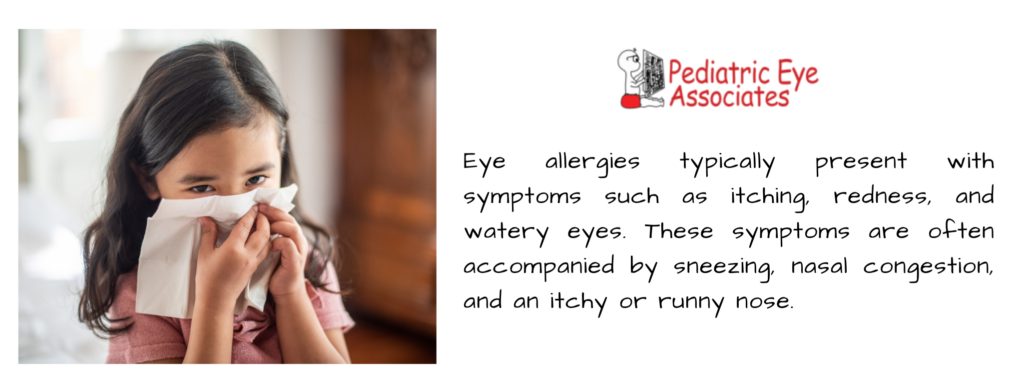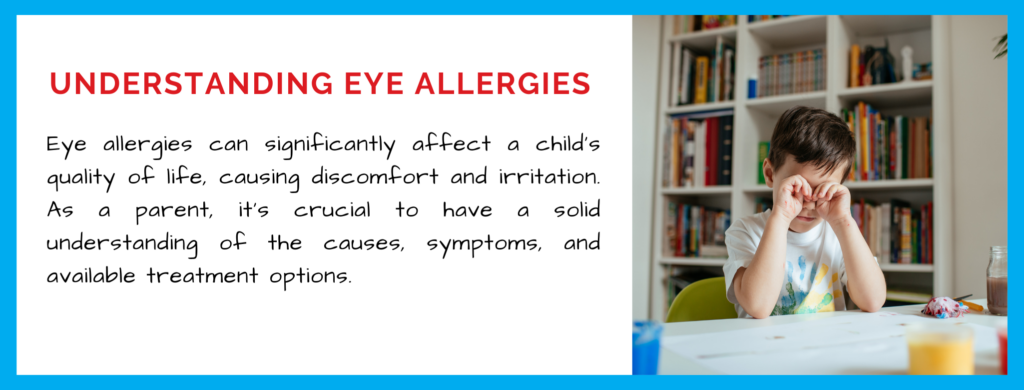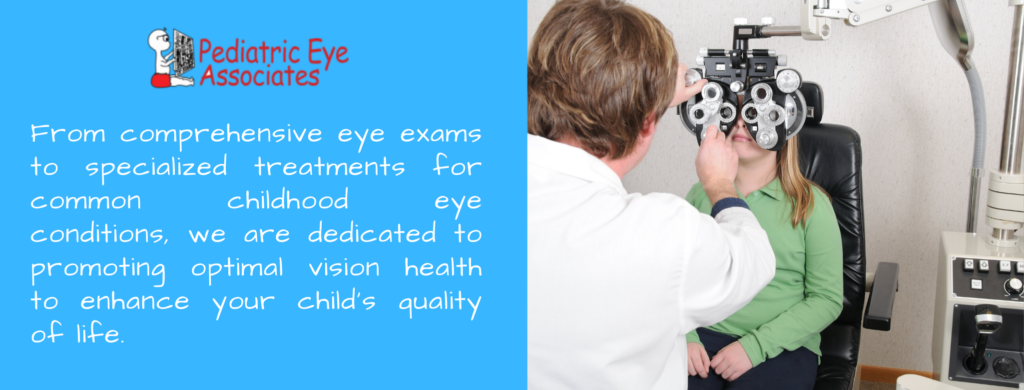Eye allergies can significantly affect a child’s quality of life, causing discomfort and irritation. As a parent, it’s crucial to have an understanding of the causes, symptoms, and available treatment options.
In this blog post, we will explore the various aspects of eye allergies in children, providing valuable insights to help you recognize, manage, and alleviate your child’s symptoms effectively.
What are eye allergies in children?
Eye allergies, also known as allergic conjunctivitis, are inflammatory reactions of the eyes that occur in children due to exposure to allergens. These allergens can include pollen, pet dander, dust mites, mold spores, and certain irritants.
When children with a predisposition to allergies come into contact with these substances, their immune system overreacts, leading to various uncomfortable symptoms.
The symptoms of eye allergies in children can manifest differently in each individual, but common signs to watch out for include:
- Redness or bloodshot eyes
- Persistent itching
- Excessive tearing or watery eyes.
- Swollen and puffy eyelids due to an inflamed conjunctiva
- Stinging or burning sensation in the eye
- Sensitivity to bright lights
- Stringy, clear, or whitish discharge from the eyes.
It’s important to note that these symptoms can vary in severity and may occur in one or both eyes. Additionally, eye allergies do not typically cause fever or body aches; these are more commonly associated with viral or bacterial eye infections.
What are the causes of eye allergies in children?
The common causes of eye allergies in children are typically the same as those in adults. These causes include:
Environmental allergens
Pollen from trees, grasses, weeds, and airborne mold spores are common environmental allergens that can trigger eye allergies in children. Exposure to these allergens can occur during specific seasons or in certain geographic areas.
Pet dander
Proteins found in the skin flakes, saliva, and urine of furry animals such as cats and dogs can trigger allergic reactions in sensitive individuals, including eye allergies.
Dust mites
These tiny insects thrive in bedding, upholstery, carpets, and stuffed toys. Their waste particles and dead bodies contain allergenic proteins that can cause eye allergies in susceptible children.
Mold spores
Mold can grow in damp areas such as bathrooms, basements, and kitchens. Mold spores released into the air can cause allergic reactions, including eye allergies.
Irritants
Substances such as smoke, perfume, strong odors, and certain chemicals can irritate the eyes and trigger an allergic response, leading to eye allergies in children.
Food allergies
While less common, specific food allergies can cause eye allergies in children. For example, allergic reactions to peanuts or shellfish may manifest as eye symptoms along with other systemic reactions.
Genetic predisposition
It’s important to note that genetic factors can also contribute to a child’s susceptibility to eye allergies. If one or both parents have allergies, their children are more likely to develop them as well, including eye allergies.
Identifying and avoiding these common irritants can help reduce the frequency and severity of eye allergy symptoms in children.
What are the triggers and risk factors for eye allergies in children?
Triggers and risk factors play a significant role in the development and exacerbation of eye allergies in children. Understanding these things is crucial for effectively managing and preventing eye allergy symptoms. Here are some common triggers and risk factors to consider:
- Seasonal allergens, such as pollens from grasses, weeds, and trees.
- Indoor allergens
- Environmental factors include high humidity, pollution, poor air quality, and industrial emissions.
- Family history of allergies
- Age
- Personal sensitivities
- Allergic rhinitis
By identifying these triggers and risk factors, parents can take proactive measures to minimize exposure to allergens and create a more allergy-friendly environment for their children. This may involve implementing proper cleaning practices, using air purifiers, avoiding known allergens, and seeking medical guidance for appropriate management strategies.
How to differentiate eye allergies from other eye conditions?
Differentiating eye allergies from other eye conditions is essential for appropriate treatment and management. Here are some key factors to consider when distinguishing which is which:
Look at the symptoms
Eye allergies typically present with symptoms such as itching, redness, and watery eyes. These symptoms are often accompanied by sneezing, nasal congestion, and an itchy or runny nose.
In contrast, eye infections, such as conjunctivitis caused by bacteria or viruses, may exhibit symptoms like thick discharge, crusting, and sticky eyelids.
Take note of the duration.
Eye allergy symptoms are often chronic or recurring, especially if triggered by specific allergens or seasonal factors. They may persist for weeks or months but tend to wax and wane.
On the other hand, eye infections generally have an acute onset and can resolve within a few days to a couple of weeks with appropriate treatment.
Allergic conjunctivitis vs. Viral/bacterial conjunctivitis
Allergic conjunctivitis, caused by allergens, typically affects both eyes simultaneously (though it may do so asymmetrically). The eyes may be itchy, watery, and mildly swollen. In contrast, viral or bacterial conjunctivitis often begins in one eye and can spread to the other. Discharge from viral conjunctivitis is usually clear or watery initially, while bacterial conjunctivitis is associated with yellow or green discharge.
Medical history
A child with a known history of allergies, asthma, or eczema is more likely to have eye allergies. Conversely, a history of exposure to someone with a contagious eye infection, recent upper respiratory infection, or contact with contaminated surfaces suggests an eye infection.
Response to treatment
Eye allergies typically respond well to antihistamine eye drops or oral antihistamines. If symptoms improve with antihistamine use, it supports the diagnosis of eye allergies. Eye infections, however, may require specific antiviral or antibiotic medications for resolution.
It’s important to note that accurate diagnosis is best obtained through a comprehensive evaluation by a board-certified optometrist or ophthalmologist. If you suspect an eye condition in your child, it is advisable to seek medical advice for a proper diagnosis and appropriate treatment.
What are the treatment options for children with eye allergies?
Effective treatment options are available to manage eye allergies in children and alleviate their symptoms. The choice of treatment depends on the severity of the symptoms and the frequency of flare-ups. Here are some common treatment options for children with eye allergies:
-
Avoidance of allergens
Identifying and avoiding allergens that trigger eye allergies is crucial. This may involve minimizing exposure to pollen, keeping indoor spaces clean, using dust mite-proof covers on bedding, and reducing contact with pets or specific food allergens, if applicable.
-
Over-the-Counter (OTC) eye drops.
OTC antihistamine eye drops can relieve itching, redness, and watery eyes. They work by blocking the effects of histamine, which is released during an allergic reaction.
It’s vital to choose eye drops specifically for allergies and nor drops that claim to “get rid of redness”.
-
Cold compresses
Applying a clean, cold compress over closed eyes can help alleviate itching, reduce inflammation, and soothe irritated eyes. This simple remedy can provide temporary relief for children experiencing eye allergy symptoms.
-
Prescription medications
A medical eye doctor may prescribe more potent antihistamine or anti-inflammatory eye drops in more severe cases or when OTC treatments are insufficient. These prescription medications can effectively reduce symptoms and provide long-lasting relief.
-
Allergy shots (Immunotherapy)
For children with persistent and severe eye allergies, allergen immunotherapy, commonly known as allergy shots, may be recommended. In this case, your care would be provided by a specialist in Allergy/Immunology.
-
Environmental control measures
Implementing measures to minimize exposure to allergens can significantly reduce eye allergy symptoms. This may include using air purifiers, keeping windows closed during high pollen seasons, regularly cleaning bedding and soft toys, and maintaining proper indoor humidity levels.
It is important to consult a pediatric optometrist or ophthalmologist to determine the most suitable treatment options for your child’s specific condition.
Where to find the best pediatric eye doctor?
Looking for exceptional eye care for your child? Look no further than Pediatric Eye Associates, the leading provider of vision care and treatment services tailored specifically for children.
Our team of experienced and compassionate professionals understands the unique needs of young patients, ensuring that every child receives the highest level of care.
From comprehensive eye exams to specialized treatments for common childhood eye conditions, we are dedicated to promoting optimal vision health to enhance your child’s quality of life.
Trust Pediatric Eye Associates for top-notch pediatric eye care that you and your child can rely on. Contact us now to learn more about our services!
The material contained on this site is for informational purposes only and DOES NOT CONSTITUTE THE PROVIDING OF MEDICAL ADVICE, and is not intended to be a substitute for independent professional medical judgment, advice, diagnosis, or treatment. Always seek the advice of your physician or other qualified healthcare providers with any questions or concerns you may have regarding your health.



